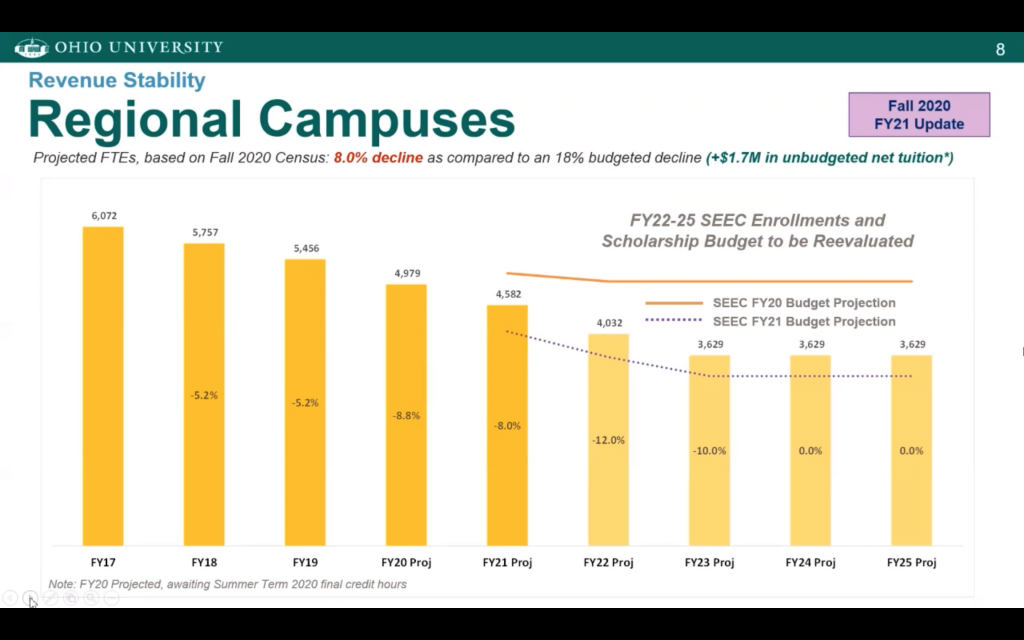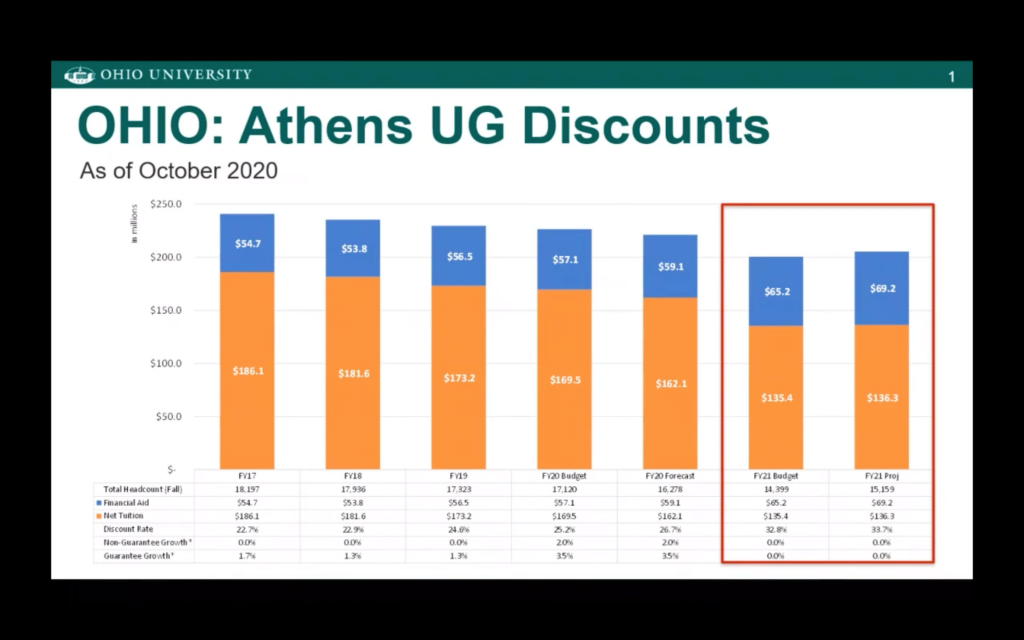News
Ohio University Projections Show Millions In Deficits
By: David Forster
Posted on:
ATHENS, Ohio (WOUB) — Ohio University is looking at a more than $290 million budget deficit over the next five years if revenue and expenses are not brought into closer alignment.
That budget gap would be plugged with money from the university’s reserves, and the biggest pool of money in these reserves could be drawn down to zero in three years under one budget scenario.
This grim news was delivered to the university’s board of trustees at its meeting last week.
https://youtu.be/YAKcNLHAIYw
University leaders said that all options are on the table as they look for ways to close the structural deficit as they come to terms with what one senior executive characterized as the “new normal.”
These options include the possibility of more layoffs and furloughs, although university leaders did not say this would in fact happen. Other options include possibly restructuring or even eliminating certain programs to better align the university with the demands of a 21st century economy.

“We have a big wall in front of us. It’s not business as usual,” Ohio University President Duane Nellis said. “We do need to think about the way that we operate.”
The budget projections delivered at the board meeting assume the university stays on its present course when it comes to spending and revenue. University leaders agreed this is unsustainable.
“This is not a plan to spend a quarter of a billion dollars,” said Elizabeth Sayrs, the university’s executive vice president and provost. “This tells us what the implications are so that we don’t do that.”
The projections show that it will take $25 million in reserves to cover the projected shortfall for the current fiscal year, which ends June 30, 2021. This shortfall is due largely to a $48.4 million drop in revenue.
The projected shortfall more than doubles in fiscal year 2022, requiring a $60.2 million draw from reserves as projected revenue continues to drop and the gap widens between revenue and expenses.
The projected shortfall grows again in fiscal year 2023, with a $68.7 million draw from reserves needed to plug the gap, and this shortfall remains about the same in fiscal years 2024 and 2025.

“The numbers are just astonishing,” trustee David Scholl said at the meeting. Even if the projected deficits could be cut in half, he said, “we’re still spending a lot of the reserves we have against a budget that’s not balanced.”
The primary reason for the big deficit projections is declining enrollment, a problem facing universities around the country.
Ohio University loses about $1 million in revenue for every 100 students it loses in enrollment. Undergraduate enrollment at Ohio University’s Athens campus is projected to drop by more than 1,700 students over the next few years. This comes on top of several years of declines already.
Not so long ago, the university was enjoying several consecutive years of record enrollment growth. That peaked in 2016 and began declining the following year.
Undergraduate enrollment in Athens for the current fiscal year is projected at 14,399. This is down nearly 1,900 students from last year.
The university is projecting three more years of decline before enrollment bottoms out in fiscal year 2024 and then notches up slightly the year after.
By way of comparison, in fiscal year 2017, the start of the decline, undergraduate enrollment in Athens was 18,209. The projection for 2024 is 12,633 undergraduates. That’s a loss of more than 5,500 students, or a drop of just over 30 percent.
The university is projecting even steeper declines at its regional campuses. Undergraduate enrollment at the regional campuses was 9,957 last year. This year it’s forecast at 8,164, a drop of 18 percent.
The regional campus forecast for the 2025 fiscal year is 6,464 undergraduate students. That’s down more than 5,600 students, or 47 percent, from the start of the enrollment decline in 2017.

The university isn’t likely to return any time soon to the big enrollment numbers that allowed it to expand staff, invest heavily in campus infrastructure and stash money aside into a rainy day fund, said Deborah Shaffer, senior vice president for finance and administration. “We have a new normal and we need to right-size for that,” she told the board.
Declining enrollment around the country means more competition for students, which drives up costs as universities spend more to recruit students, including offers of financial aid.
Tuition is by far the biggest source of revenue for most universities, including Ohio University. The revenue earned through tuition is offset by how much the university spends on financial aid.

During the previous school year, Ohio University collected about $221.2 million in undergraduate tuition. This was offset by $59.1 million spent on financial aid, resulting in a net of $162.1 million in tuition revenue. This year, the university forecasts it will receive $205.5 in undergraduate tuition and spend $69.2 million in financial aid, for a net of $136.3 million.
The bottom line is the university will spend significantly more financial aid as it receives significantly less in tuition due to declining enrollment. This is the cost of doing business in a tighter market.
Meanwhile, the coronavirus has taken, and continues to take, a big bite out of the university’s budget.
The biggest hit was in room and board revenue. The previous school year saw a $22.5 million, or nearly 25 percent, drop in room and board revenue as the university made refunds to students after the campus was shut down following spring break.
This year, with the residence halls at only a fraction of their capacity because of the pandemic, room and board revenue is expected to drop another $27.4 million, or 40 percent.
Overall, the university is projecting $64.7 million in lost revenue through the end of December because of the coronavirus.
“We have a new normal and we need to right-size for that.” – Deborah Shaffer, SVP Finance
On top of this are the additional expenses of dealing with the pandemic, including costs for personal protective equipment and other safety equipment, additional cleaning, additional costs for migrating classes online and costs for COVID-19 testing and contract tracing.
The university projects these expenses will add up to about $14.5 million by the end of December.
It’s unknown how much the coronavirus will continue to cost the university beyond December since the plans for spring semester have not been finalized. The total cost will determine how much more the university will need to dip into its reserves to cover its deficits.
Note: A paragraph in the story addressing tuition revenue and financial aid was updated to more accurately reflect how much the university earns in tuition relative to how much it spends on financial aid.
Ohio University holds WOUB Public Media’s license to operate.

